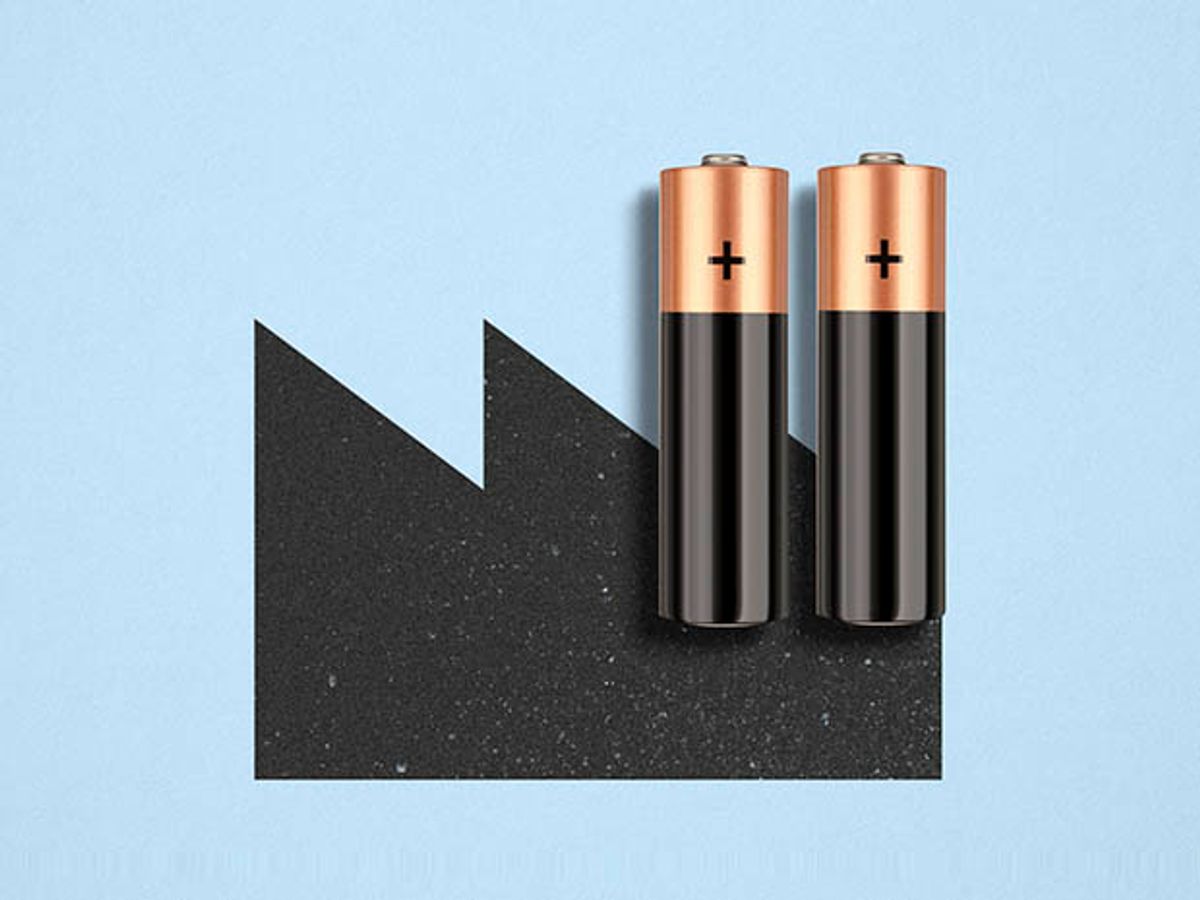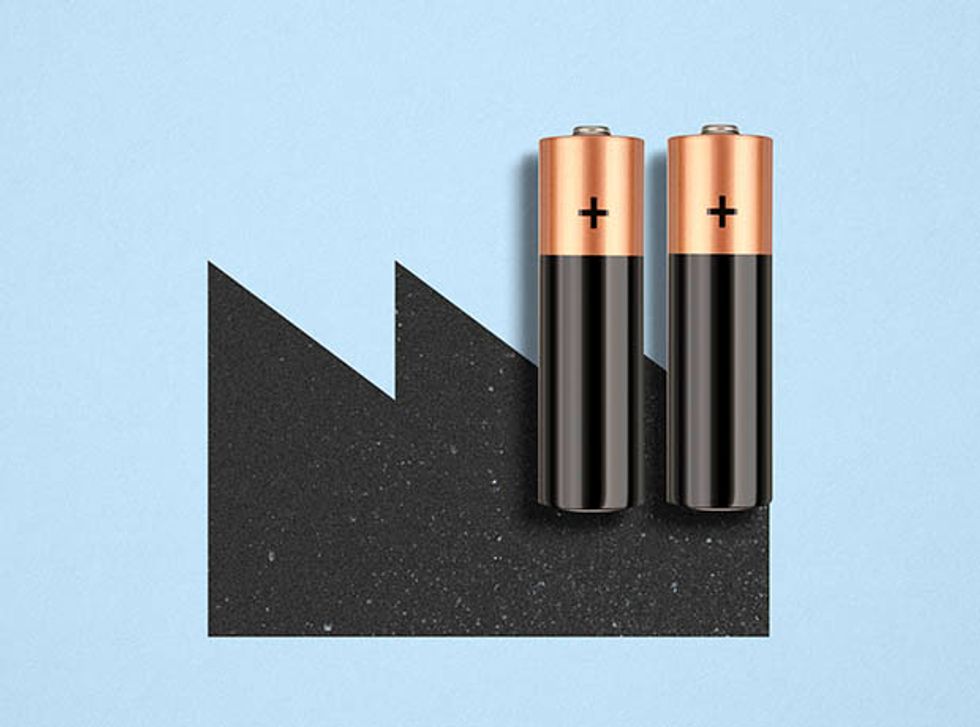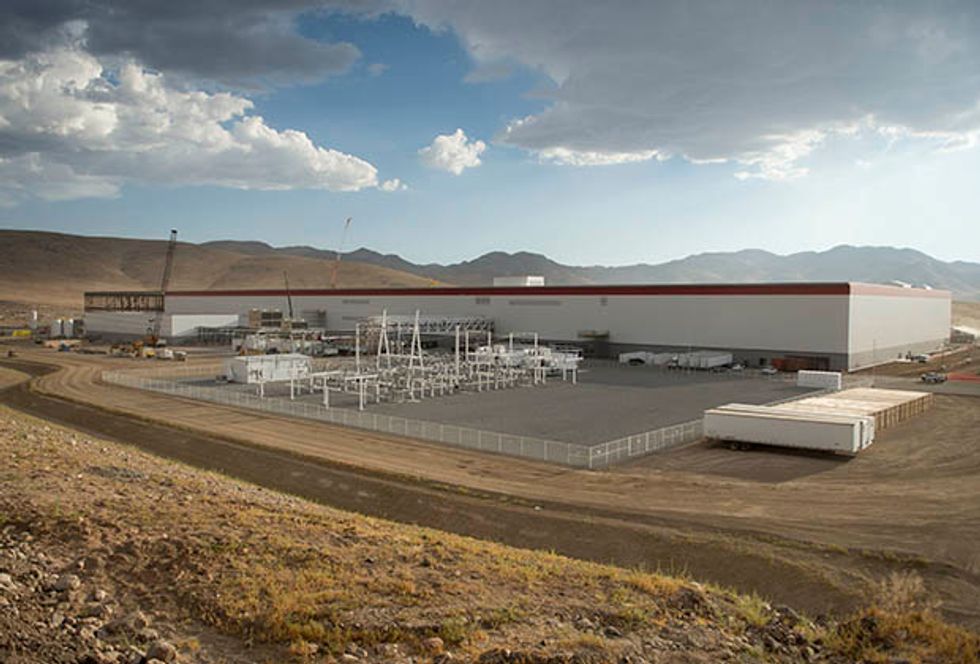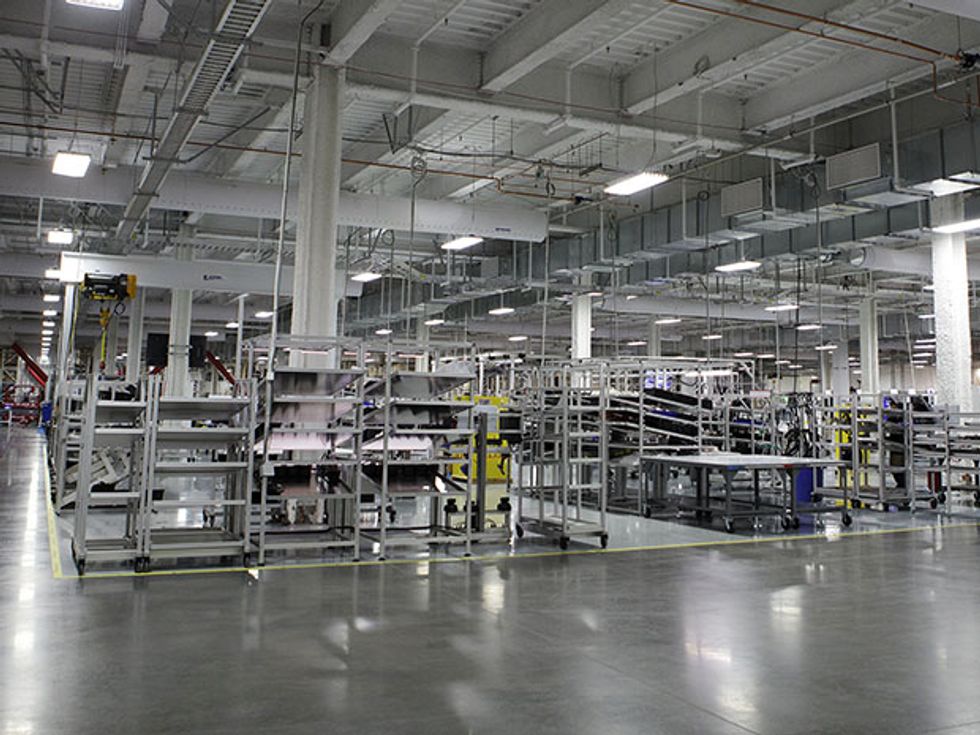2017 Is the Make-or-Break Year for Tesla’s Gigafactory
Finally the company’s lithium-ion batteries will start coming off the line. But will they juice Tesla’s fortunes?


Three years ago, Tesla Motors announced its plans to build the Gigafactory, a sprawling lithium-ion battery plant in the parched hills outside Sparks, Nev. Nothing remotely like it had ever been proposed. The Gigafactory, Tesla CEO Elon Musk proclaimed, would be the world’s biggest building by footprint, spanning 107 American football fields, and it would produce at least 35 gigawatt-hours of batteries per year—more than the entire global output of lithium batteries in 2013.
“It has to be big because the world is big,” Musk said last July. The Gigafactory would make batteries cheaper than ever before, which would in turn ramp up electric vehicle sales and meaningfully cut petroleum consumption everywhere.
The Gigafactory’s promise to push lithium batteries to unprecedented scale quickly became a symbol that clean energy could be big and powerful, and the very idea of it shifted the trajectories for both the automotive and energy-storage industries. Competing automakers doubled down on electric-vehicle development, while energy storage vendors scaled up battery production and slashed prices. According to the energy market research firm Navigant Research, Tesla’s push is a leading factor behind a projected 60 percent growth in sales of battery EVs in 2017.
The Gigafactory did all that without producing a single EV battery—a situation that’s about to change. Within the next several months, the first battery packs produced entirely in house are set to begin rolling off the assembly lines. By midyear, the plant will need to crank out 75 Li-ion cells per second for the Model 3, Tesla’s much-anticipated electric car for the masses. It will also need to ramp up production of Powerwalls and Powerpacks, the company’s energy-storage systems for homes and commercial and utility use. And to continue meeting orders, the battery plant must reach its 35-GWh annual capacity sometime next year. In short, 2017 is when the Gigafactory must swing from icon to efficient mass producer.
At press time, the Gigafactory was still a work in progress. Already, stationary storage units were being assembled there, but using imported battery cells. According to Tesla, the facility was on track to begin mass production by the end of 2016. However, a source at Panasonic, Tesla’s partner in the Gigafactory, told IEEE Spectrum that “by April” was the best they could guarantee.
Tesla has “a lot to prove,” says Mark Muro, who studies manufacturing as a senior fellow at the Brookings Institution, a Washington, D.C–based think tank. “They are attempting novel processes in short time frames and asserting that they can reinvent manufacturing along with everything else. They have a lot riding on this. These are huge gambles.”
Investing in battery manufacturing was an act of necessity for Tesla. While other automakers rely on pouch-shaped Li-ion cells specially designed for EVs, Tesla powered its first all-electric cars using the same cylindrical “18650” Li-ion cells employed in laptop batteries; it purchased those cells from Panasonic. That approach was fine so long as Tesla made only high-end EVs like the Model X and Model S. To be profitable, though, the company needs the mass-market US $35,000 Model 3, and it needs to produce at least a half-million cars per year. Battery vendors were unlikely to guarantee to supply batteries on that scale unless Tesla put some skin in the game, says Sam Abuelsamid, Navigant’s Detroit-based senior research analyst.
The Gigafactory did that, partnering Tesla with Panasonic. The lithium battery giant brings its expertise, supply chain, and capital, supplying up to $1.6 billion of the $5 billion in total investment. The state of Nevada kicked in incentives worth a reported $1.3 billion. The rest is coming from Tesla.

The Gigafactory is a vision of vertical integration, with raw materials to arrive at one end and finished products to exit at the other. It all begins at the automated cell lines, which are owned and operated by Panasonic. There, active powders are mixed with a liquid to form a slurry and then coated onto metal foils to form a cathode and an anode; the foils, along with porous separators, are rolled into a cylinder and filled with a Li-ion-conducting electrolyte, and caps are added to form a cell that looks like an oversized AA.
In the Tesla section of the Gigafactory, hundreds of cells get packaged with electronics and cooling systems to form a complete battery module. Packs for the Model 3 will be trucked to its car plant in Fremont, Calif.; Powerpacks and Powerwalls head straight to market.
During the three years it took to get the Gigafactory running, Tesla’s competitors didn’t stand still. The Gigafactory made Tesla’s affordable Model 3 look real, compelling the big automakers to match its target 346-kilometer (215-mile) range for their own mass-market EVs, says Abuelsamid. Some of those competing EVs are already in showrooms or soon will be, leading off with GM’s 383-km-range Chevrolet Bolt, which has a starting price of $37,495. Long-range mass-market EVs are also expected from Hyundai and Ford in 2017 and from Nissan and Volkswagen in 2018.
The wave of upgraded EVs in turn led to an uptick in battery development and manufacturing by not only Panasonic but also Korea-based LG Chem and Samsung and China’s BYD. Meanwhile, a price war led lithium battery prices to plummet, says Ravi Manghani, energy storage director at Boston-based GTM Research. Since 2014, the cost of completed packs has crashed from $400/kWh to below $200/kWh for some stationary storage systems, he says. Similar reductions have hit the automotive market. GM has said it’s paying LG $145/kWh for the cells in the 2017 Bolt battery pack.
The Gigafactory’s greatest impact may have been on itself. In April 2016, after Tesla unveiled the Model 3’s design, nearly 400,000 preorders rolled in. One month later Musk vowed that Tesla would fulfill at least 100,000 of those orders in 2017, starting in July, and produce a half-million EVs in 2018. Hence the push to reach 35 GWh by next year, two years ahead of the original plan.
There is good reason to move fast: Tesla will soon see its federal subsidies fall away. The $7,500 U.S. federal income tax credit for buying a battery EV ratchets down to zero within 18 months after a manufacturer sells its 200,000th battery EV. Tesla could hit that threshold in 2017, well ahead of its competitors. And unlike other automakers, who can subsidize their EVs through profits from conventional cars and trucks, Tesla sells EVs exclusively.
The battery is still the priciest component of an EV. Tesla asserted at the outset that the Gigafactory would drive down the per kWh cost of its battery packs by more than 30 percent within the first year of Model 3 production. Whether it can deliver a competitive advantage, however, is an open question. Navigant Research estimates that GM pays $16,200 to $16,800 for each 60-kWh Bolt pack. Abuelsamid figures a roughly 55-kWh Model 3 pack will run anywhere from $13,000 to $16,500.

Musk has also touted the Gigafactory’s economies of scale. Experts, however, are less sanguine on the benefits of large volumes. New research on EV battery manufacturing from Carnegie Mellon University considered a bevy of factors impacting lithium cell production, including costs to install and operate machinery, labor, cycle times, and unplanned downtime. Looking at both pouch-shaped lithium cells and the cylindrical cells favored by Tesla, the CMU researchers found that economies of scale level off by 1 GWh—a volume already achieved by Panasonic and other battery makers. “Beyond 1 GWh, you’re just building multiple parallel manufacturing processes. There’s not any savings from having bigger machines,” says Rebecca Ciez, a doctoral student who conducted the study with CMU’s Jay Whitacre, an engineering professor and founder of battery startup Aquion Energy.
Giorgio Rizzoni, director of Ohio State University’s Center for Automotive Research, agrees that economies of scale are finite and says CMU has a “credible model of where that ceiling is.” Rizzoni notes that innovative manufacturing, waste reduction, and vertical integration of cell and module assembly could lower costs at the Gigafactory.
But exactly where will the big cost reductions come from? Panasonic, for example, says that its Gigafactory machines are no different from the ones used in its other Li-ion battery operations. Musk and Tesla chief technical officer J.B. Straubel extol the factory’s layout, which squeezes out wasted space. “Everything is basically almost touching each other on every floor,” said Straubel. The result, they say, is a tripling of the gigawatt hours that the Gigafactory can produce.
But more output per square foot may do little for battery costs. In CMU’s modeling, the building accounts for only about 3 percent of costs. Several experts told Spectrum that tighter spacing could actually hamper product yield and line utilization, by making equipment harder to maintain and replace.
And the vertical integration at the Gigafactory may be missing the biggest cost saver of all: making the cathode materials. CMU’s Ciez says that suppliers of nickel cobalt aluminum oxide and nickel manganese cobalt powders command large markups. Tesla declined to comment on whether the Gigafactory will make these powders.
Muro of the Brookings Institution says assembling the Gigafactory’s workforce may also be a challenge. Tesla has promised to hire half of the Gigafactory’s projected 6,000 workers in-state. That could be tough, says Muro. A 2014 report that he coauthored on the Nevada economy identified a “proficiency crisis” in the state’s science, technology, engineering, and math education.
The one move that does seem likely to cut costs has less to do with the Gigafactory and more to do with the design of Panasonic’s cells, which will be 3 millimeters longer and 5 mm fatter than commodity 18650 cells. CMU estimates that the larger format, along with thicker electrodes, could reduce cell costs by about 25 percent. But CMU’s research also suggests that even greater cost reductions are possible through similar tweaks to pouch-shaped cells. GM has said that it expects Bolt cell costs to drop to $100/kWh by 2020.
Meanwhile, it’s unclear whether the Model 3 will be ready by mid-2017. Missing target dates is a Tesla tradition. An analysis by TheWall Street Journal last August found that the company failed to meet 20 of Musk’s projections over the past five years and missed 10 goals by “an average of nearly a year.” Navigant’s Abuelsamid predicts the Model 3 will miss its launch date by a year.
Failure to hit the Model 3 schedule could leave Tesla holding a big bag of batteries. While the details of the Panasonic-Tesla partnership are confidential, Tesla’s latest quarterly report acknowledges that it is committed to buying $1.7 billion of the cells produced at the Gigafactory, offsetting the $1.6 billion that Panasonic is investing in the facility.
Some of those cells will be absorbed by Powerwalls and Powerpacks. The utility-scale Powerpack has been winning large orders in an accelerating market. An 80-MWh Powerpack system being installed at a Southern California Edison substation is the world’s largest Li-ion battery storage project to date. And Tesla’s recently announced solar roof could boost sales of home-size Powerwalls. But lithium storage is still too pricey for most homeowners. “The costs have to be about half or a quarter of where there are today for some level of residential adoption,” says GTM Research’s Manghani.
Amid all this uncertainty, one thing is clear: There could be real consequences to getting it wrong. Musk and his various ventures are already stretched thin, among other things managing defects in Model X that earned Tesla a bottom spot in Consumer Reports’ latest reliability rankings; saving debt-ridden solar installer SolarCity, which Tesla recently acquired; and troubleshooting SpaceX, the rocket venture grounded by a September 2016 launchpad explosion. A misstep in any of these endeavors could mean a painful reckoning.
Musk himself has felt the strain. On an earnings call with industry analysts in October, he said that camping out in Tesla’s Fremont factory last year and fixing “broken” elements that were impeding EV production rates “probably took a year off my life, or more.” And in a blog post last July, just before the Gigafactory’s opening ceremony, he conceded that what he was doing was crazy. Given the long list of American carmakers that have failed, wrote Musk, “starting a car company is idiotic and an electric car company is idiocy squared.”



